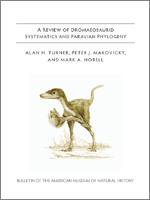Coelurosauria is the most diverse clade of theropod dinosaurs. Much of this diversity is present in Paraves—the clade of dinosaurs containing dromaeosaurids, troodontids, and avialans. Paraves has over 160 million years of evolutionary history that continues to the present day. The clade represents the most diverse living tetrapod group (there are over 9000 extant species of Aves—a word used here as synonomous with “bird”), and it is at the root of the paravian radiation, when dromaeosaurids, troodontids, and avialans were diverging from one another, that we find the morphology and soft tissue changes associated with the origin of modern avian flight. Within the first 15 million years of known paravian evolutionary history members of this clade exhibited a difference of nearly four orders of magnitude in body size, a value that is similar to the extreme body size disparity present today in mammalian carnivorans, avians, and varanoid squamates. In this respect, Paraves is an important case study in characterizing the patterns, processes, and dynamics of evolutionary size change. This last point is of particular interest because of the historical significance placed on the role of body size reduction in the origin of powered avian flight.
Our study reviews and revises the membership of Dromaeosauridae and provides an apomorphy-based diagnosis for all valid taxa. Of the currently 31 named dromaeosaurid species, we found 26 to be valid. We provide the most detailed and comprehensive phylogenetic analysis of paravians to date in order to explore the phylogenetic history of dromaeosaurid taxa. The general pattern of paravian relationships is explored within the broader context of Coelurosauria with an emphasis on sampling basal avialans, because of their importance for character optimizations at the base of Paraves.
A large dataset was constructed by merging two datasets, one examining coelurosaur relationships broadly (based on previous TWiG datasets) and the other examining avialan relationships specifically (Clarke et al., 2006). This merged dataset was then significantly revised and supplemented with novel character analysis focusing on paravian taxa. During character analysis, particular attention was given to basal members of Dromaeosauridae, enigmatic basal paravians such as Jinfengopteryx elegans and Anchiornis huxleyi, and the incorporation of new morphological information from two undescribed troodontid species from the Late Cretaceous of Mongolia. A final dataset of 474 characters scored for 111 taxa was used to address paravian evolution. This dataset is important in that it bridges a phylogenetic gap that had persisted between studies on birds and studies on all other coelurosaurs. Most scorings in this matrix were based on the direct observation of specimens.
All most parsimonious trees recovered in the cladistic analysis support the monophyly of Paraves, Troodontidae, Dromaeosauridae, and Deinonychosauria. A new clade of basal troodontids is discovered including two undescribed Mongolian troodontids and Jinfengopteryx elegans. Xiaotingia and Anchiornis form a clade at the base of Troodontidae. Recently proposed relationships within Dromaeosauridae are further supported and a succession of clades from Gondwana and Asia form sister taxa to a clade of Laurasian dromaeosaurids. Avialan monophyly is strongly supported with Archaeopteryx, Sapeornis, Jeholornis, and Jixiangornis forming the successive sister taxa to the Confuciusornis node.





